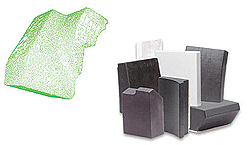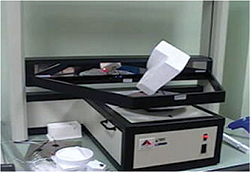 Situation
Situation
NASA routinely performs maintenance and repair on the 40,000+ unique heat resistant tiles covering the space shuttle. Tiles are usually repaired by removing them, filling the space with plaster, and then machining a new one based on the shape of the plaster.
The new tiles must be made accurately to keep an airtight seal between them – any hot gasses trapped behind tiles during reentry could cause them to fail. NASA needed to upgrade their tile-repair system to an automated, CAD-based solution.
Looking great, thanks. You guys sure are fast over there!”
 Solution
Solution
NASA contracted 3DScanCo — a division of Laser Design Inc — to develop a custom 3D scanning solution designed to help automate damage repair on the shuttle tiles. 3DScanCo worked with NASA to develop a series of performance and tolerance goals needed for the project and evaluate potential scanning technologies.
3DScanCo developed a custom scanning system that fully automated the tile repair and fabrication process. The custom scanner uses a turntable to accurately scan and generate point cloud data for the tiles, which are then auto-surfaced using NURBS surfaces. The resulting CAD data is then used to machine an exact copy of the tile for replacement on the shuttle.
 Results
Results
When 3DScanCo started on the project, NASA was using a manual tracer mill to literally trace a plaster impression (splash) while milling out a new part via mechanical linkages connected between the two.
NASA has been able to use 3DScanCo’s and Laser Design Inc’s custom 3D scanning system to automatically generate replacement tiles, lower labor costs and repair time, and generate CAD data documenting the legacy shuttle tiles. NASA has since upgraded the equipment and is now using it for other applications such as accident reconstruction.
